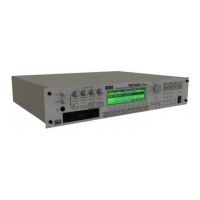23
Quick Start
Using the arpeggiator as you play in Combi-
nation mode
In Combination mode the TRITON-Rack provides dual
arpeggiators, allowing you to run two arpeggio pat-
terns simultaneously.
1 Press the [COMBI] key to enter Combination
mode, and select a combination. (
☞p.19 “2. Listen-
ing to the sound of a combination”)
As you select various combinations, you will notice
that the [ARP ON/OFF] key LED will light for some
combinations. (
☞“Other settings for the arpeggia-
tor”) When you press the keyboard, the arpeggiator
will start.
For other combinations, you can press the [ARP
ON/OFF] key (the LED will light) to turn on the
arpeggiator.
2 As described in the preceding section “Settings
using controllers” and the following section “Set-
tings in the LCD screen,” move the controllers or
modify the parameters to change the way in which
the arpeggios are played.
The [ARP ON/OFF] key and the C-mode
[TEMPO], [ARP-GATE], and [ARP-VELOCITY]
knobs are valid for both arpeggiators A and B.
Their state will be memorized when the combina-
tion is written.
Settings in the LCD screen
● In COMBI 1.1: Play, press the [F4] key to select the
Arp. Play A page, and make settings for arpeggia-
tor A.
In COMBI 1.1: Play, press the [F5] key to select the
Arp. Play B page, and make settings for arpeggia-
tor B.
Select the arpeggiator(s) that will run
Use the “Arpeggiator Run” check boxes to specify the
arpeggiator(s) that you want to run. The arpeggiator(s)
that are checked here will operate when the [ARP ON/
OFF] key is on.
However, the arpeggiator will play a timbre only if the
table displayed beside the check boxes assigns arpeg-
giator A or B to a Ttimbre 1–8. These settings are made
in COMBI 6.1: Ed-Arp., Setup page “Assign” (
☞p.87).
Arpeggiator-A, Arpeggiator-B
For each arpeggiator A and B, you can make settings
for “Pattern,” “Reso (Resolution),” “Octave,” “Sort,”
“Latch,” “Key Sync,” and “Keyboard.” (
☞p.85)
Checking the structure of a user arpeggio pattern
Let’s see how combination I-B 063: Echo Jamm is con-
structed.
1 Select combination I–B 063: Echo Jamm, and look
at the Arp. Play A page and Arp. play B page.
• As you can see from the “Timbre Assign” table in
the upper right, arpeggiator A is assigned to
timbre 4, and arpeggiator B is assigned to timbre 2.
When you play the keyboard of a connected MIDI
instrument, the U168 (I-A/B): BigBeats 1 arpeggio
pattern will play the program I-B068: Drum’n’Bass
Kit of timbre 4. The U096 (I-A/B): Stab Rhythm
arpeggio pattern will play the program I-B053:
Funkin’ Guitar of timbre 2.
• If you uncheck “Arpeggiator Run A” or
“Arpeggiator Run B,” the unchecked arpeggiator
will stop.
If you check it once again and play the keyboard,
the arpeggiator will begin running.
• Look at the COMBI 6.1: Ed-Arp., Zone page, and
you will see that the A keys “Btm” and “Top” are
set so that arpeggiator A will operate only for B3
and lower keys, and that the B “Top Key” and
“Bottom Key” are set so that arpeggiator B will
operate only for C4 and higher keys.
Other settings for the arpeggiator
You can also set “Gate,” “Velocity,” “Swing,” and
“Scan Zone.” These parameters are set in PROG 6.1:
Ed–Arp, COMBI 6.1: Ed–Arp. (
☞p.85).
Linking the arpeggiator to program, combinations
You can specify whether the arpeggiator settings writ-
ten in a program or combination will also be selected
when you switch programs or combinations, or
whether the arpeggiator status will not change when
you switch programs or combinations.
With the factory settings, the former is selected. Use
the latter when you want to keep the same arpeggio
pattern running, and change only the program sound.
This setting is made in “Auto Arp.” (GLOBAL 1.1: Sys-
tem, Basic).
Creating an user arpeggio pattern
Arpeggio patterns that you create can be written to
U000 (I–A/B)–327 (E–H).
These can be created in GLOBAL 6.1: Arp.Pattern
(
☞p.89).

